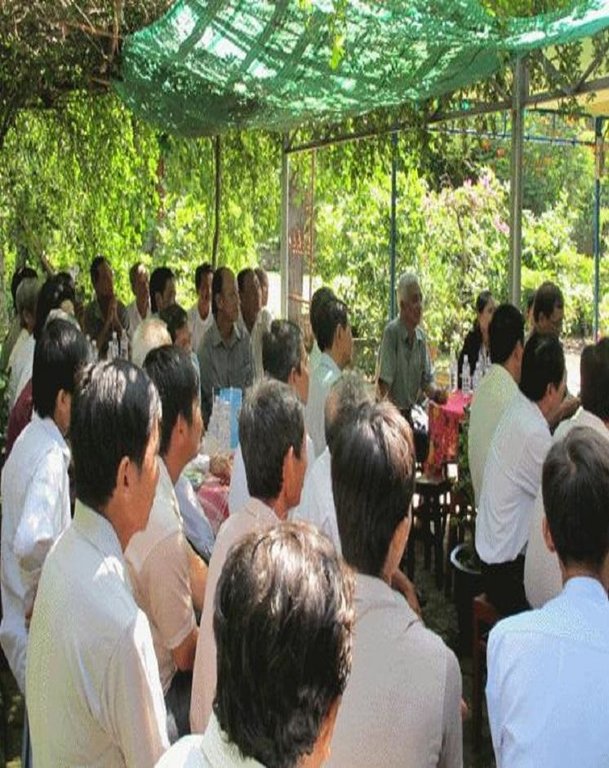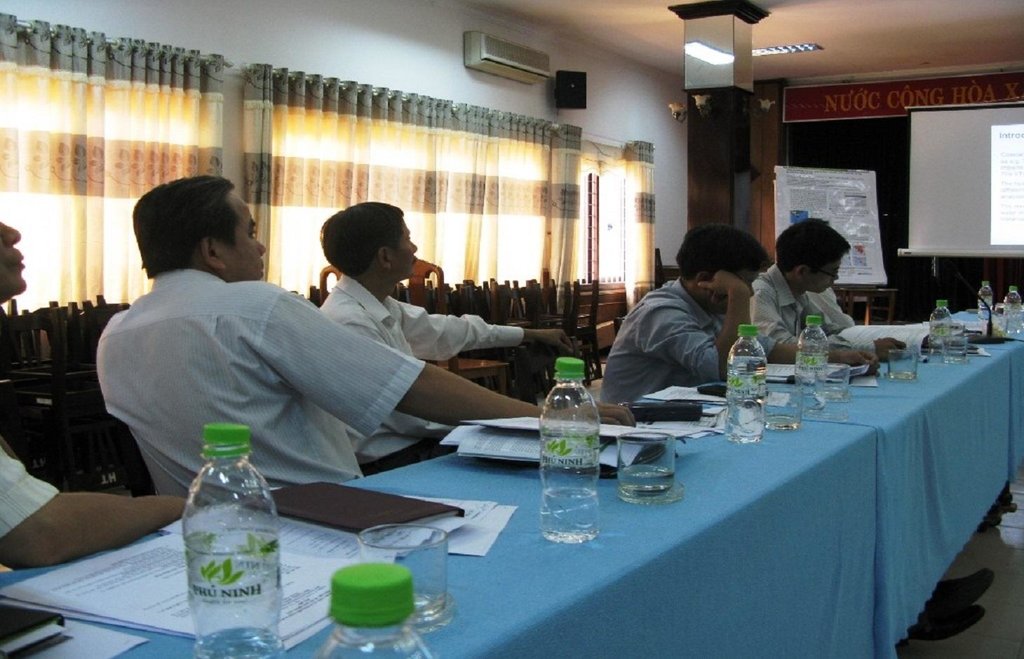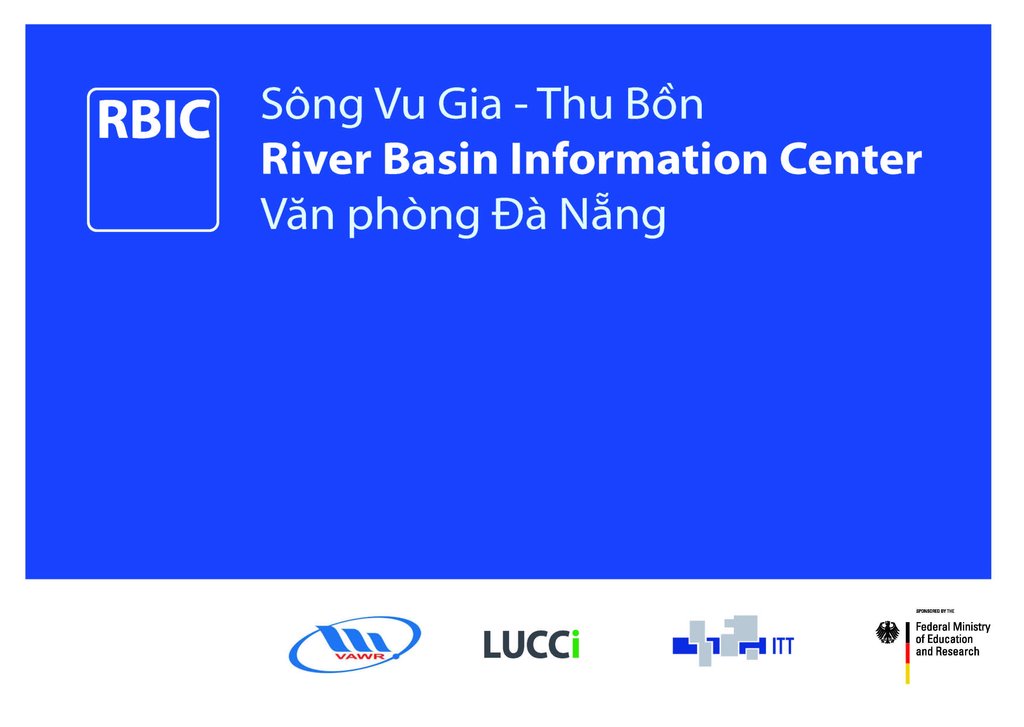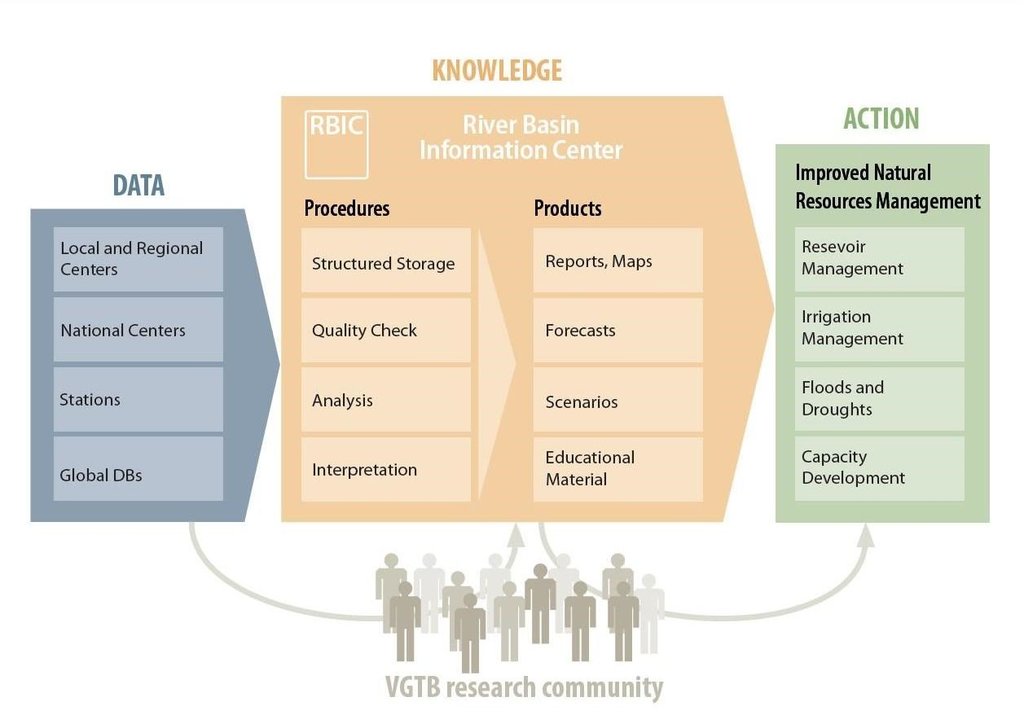Vu Gia Thu Bon River Basin Information Centre [Vietnam]
- Creación:
- Actualización:
- Compilador: Justyna Sycz
- Editor: –
- Revisores: Fabian Ottiger, Deborah Niggli
Trung tâm thông tin lưu vực sông VGTB (Vietnamese)
approaches_2536 - Vietnam
Visualizar secciones
Expandir todo Colapsar todos1. Información general
1.2 Detalles de contacto de las personas de referencia e instituciones involucradas en la evaluación y la documentación del Enfoque
Especialista MST:
Nauditt Alexandra
alexandra.nauditt@th-koeln.de
University of Applied Science, TH Köln
Alemania
Especialista MST:
Ribbe Lars
lars.ribbe@th-koeln.de
University of Applied Science, TH Köln
Alemania
Especialista MST:
Nguyen Phong
phongicd@gmail.com
Vietnam Academy for Water Resources
Hanoi
Vietnam
Nombre del proyecto que facilitó la documentación/ evaluación del Enfoque (si fuera relevante)
Book project: Making sense of research for sustainable land management (GLUES)Nombre de la(s) institución(es) que facilitaron la documentación/ evaluación del Enfoque si fuera relevante)
University of Applied Science, TH Köln (TH Köln) - AlemaniaNombre de la(s) institución(es) que facilitaron la documentación/ evaluación del Enfoque si fuera relevante)
Vietnam Academy for Water Resources (VAWR) - Vietnam1.3 Condiciones referidas al uso de datos documentados mediante WOCAT
¿Cuándo se compilaron los datos (en el campo)?
27/07/2015
El compilador y la/s persona(s) de referencia claves aceptan las condiciones acerca del uso de los datos documentados mediante WOCAT :
Sí
1.4 Referencia/s al/los Cuestionario(s) de Tecnologías MST
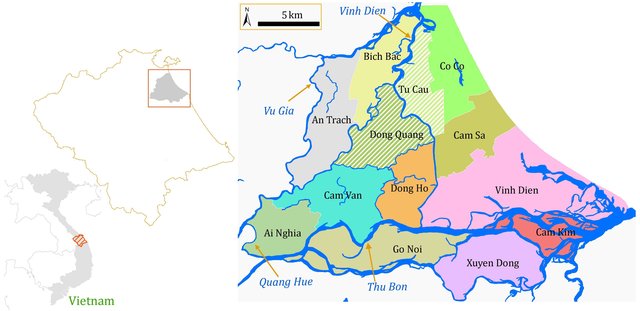
Water saving through reuse of return flow in … [Vietnam]
Return flow from paddy fields is strategically collected before being lost to rivers and is reused as an effective source of agricultural water.
- Compilador: Justyna Sycz
2. Descripción del Enfoque MST
2.1 Breve descripción del Enfoque
The VGTB River Basin Information Centre (RBIC) offers decision support tools for stakeholders and aims at providing comprehensive information and consulting services to the water and land users according to their demands.
2.2 Descripción detallada del Enfoque MST
Descripción detallada del Enfoque MST:
Aims / objectives: Sufficient and sustainable water resource management at river basin scale can only be achieved if it is based on dialogue between all relevant stakeholders, and supported by adequate data. It follows then, that a robust system of monitoring, evaluation, reporting and communication is needed. The lack of appropriate management strategies which would bring these tools together has been underlined by stakeholders, and observed by researchers, involved in the research project LUCCi - Land Use and Climate Change Interactions in the VGTB River Basin. In order to offer a comprehensive decision-making support system, based on scientific knowledge and research results, the Institute for Technology and Resources Management (ITT, TH Köln, Germany) in cooperation with the Vietnam Academy for Water Resources (VAWR, Hanoi, Vietnam) established the VGTB River Basin Information Centre in Da Nang. The overall objective of RBIC is to support efficient and sustainable water and land use. The support provided for the implementation of the water saving technology for paddy systems is one of the services offered by the centre.
Methods: The VGTB RBIC is an independent, local institution administrated by the German and Vietnamese coordinators of LUCCi, financed by project sources and located at the Central Department of the Vietnam Academy of Water Resources in Da Nang. As a scientific organization, the VGTB RBIC provides the advantages of impartiality, a detailed knowledge base and a broad interdisciplinary perspective. Through different dissemination activities, such as visits to relevant institutions, information material (brochures, flyers in Vietnamese) as well as training courses and capacity building measures, the relevant stakeholders are well-informed about the activities of the Information Centre. On demand, the following products and services are provided in the VGTB-RBIC: (a) Thematic maps on land use, hydrology and river basin development; (b) A comprehensive database of the VGTB river basin (VGTB RBIS - River Basin Information System, open source) (c) VGTB State of the Basin Report as a decision-support instrument: the report was prepared by the LUCCi research team and provides relevant information on climatic, environmental and socioeconomic data and trends; (d) Hydro-meteorological, hydrograph and salinity data; (e) Flood and drought risk assessment; (f) Scenarios and modelling (reservoir operation, salinity intrusion, irrigation management scenarios); (g) Organization of meetings and discussions on key issues of the development of the VGTB; (f) Training and capacity building services related to the demands of stakeholders.
Role of stakeholders: Thus a heterogeneous stakeholder platform has been established in the case study region that includes scientific institutions, policy makers, public administration representatives as well as private sector companies. It is clear that the major problems of the VGTB River Basin can be only addressed, and adequate solutions identified, if based on active cross-sectoral stakeholder participation. Therefore, the interaction among stakeholders and RBIC plays a key role: the services are offered for the stakeholders, and stakeholder feedback is the basis for providing adequate information services and conducting applied based research.
2.3 Fotos del Enfoque
2.5 País/ región/ lugares donde el Enfoque fue aplicado
País:
Vietnam
Región/ Estado/ Provincia:
Da Nang
Especifique más el lugar :
Central Vietnam
2.6 Fechas de inicio y conclusión del Enfoque
Indique año del inicio:
2013
Año de conclusión (si el Enfoque ya no se aplica):
2015
2.7 Tipo de Enfoque
- proyecto/ basado en un programa
2.8 Propósitos/ objetivos principales del Enfoque
The Approach focused mainly on other activities than SLM (Water management, agriculture, irrigation, water availability: support the local water users in the implementation of adequate water management strategies)
1. Establish a communication platform to discuss water and land use related problems, and create transparency among water users.
2. Support and foster the science-policy-society dialogue offering a cross-sectoral neutral space for discussion, consulting and capacity building for all stakeholders and water users (farmers, decision-makers, public institutions, private sector companies).
3. Provide a comprehensive information service and decision support system to stakeholders according to their demands. The following specific products and services are provided by the VGTB-RBIC: Thematic maps on land uses, hydrology and river basin development • Comprehensive database of the VGTB river basin (VGTB RBIS - River Basin Information System, open source) • VGTB State of the Basin Report as a decision support instrument: the report was prepared by the LUCCi research team and provides relevant information on climatic, environmental and socioeconomic data and trends • Hydro-meteorological, hydrograph and salinity data • Flood and drought risk assessment • Scenarios and modelling (reservoir operation, salinity intrusion, irrigation management scenarios) • Organization of meetings and discussions on key issues of the development of the VGTB • Training and capacity building services related to the demands of stakeholders.
The SLM Approach addressed the following problems: The lack of communication between the relevant institutions and water users, the demand for comprehensive decision-support instruments, difficulties with data availability - typically distributed and available at different institutions, as well as conflicts over resource use, were the main problems addressed by the approach. The conflicts caused by the rapid expansion of hydropower since 2008 in the VGTB river basin have especially demonstrated the inadequate participation of local stakeholders in planning processes. Hydropower development has adverse effects on downstream water availability, especially during the dry season, affecting drinking water supply and irrigation.
2.9 Condiciones que facilitan o impiden la implementación de la/s Tecnología/s aplicadas bajo el Enfoque
entorno institucional
- impiden
Lack of communication between the institutions and inadequate stakeholder involvement in the decision making process.
Treatment through the SLM Approach: VGTB RBIC offers a cross sectoral communication platform and bring together all relevant stakeholders: organization of workshops and meetings as well as visits to the relevant institutions.
conocimiento de MST, acceso a apoyo técnico
- impiden
A robust system of monitoring system was missed in the region: hydro-meteorological data, monitoring of water quantity.
Treatment through the SLM Approach: A monitoring network has been established as part of the LUCCi project.
otros
- impiden
Lack of information about the river basin in order to ensure an adequate decision making.
Treatment through the SLM Approach: A “State of the Basin Report” including all available data and information about the river basin has been elaborated (climatic, environmental, hydrological, land use and socioeconomic data and trends); River Basin Information System: Comprehensive data base of the VGTB river basin through the open source VGTB River Basin Information System.
3. Participación y roles de las partes interesadas involucradas
3.1 Partes interesadas involucradas en el Enfoque y sus roles
- investigadores
National and international researchers involved in the LUCCi project
- ONG
Authorities of a Water Management Unit (WMU)
- gobierno nacional (planificadores, autoridades)
Regional relevant institutions (DONRE, MARD, PPC Quang Nam)
- organización internacional
3.2 Involucramiento de los usuarios locales de tierras/ comunidades locales en las distintas fases del Enfoque
| Involucramiento de los usuarios locales de tierras/ comunidades locales | Especifique quién se involucró y describa las actividades | |
|---|---|---|
| iniciación/ motivación | pasivo | Stakeholder analysis (including of all ineterested groups) |
| planificación | pasivo | Local and regional decision makers are involved: workshops, discussions and surveys in order to collect relevant socio-economic and land use data, identify research demand and challenges |
| implementación | apoyo externo | Land user decide on whether and which technologies they want to implement. |
| monitoreo y evaluación | ninguno | |
| Research | interactivo | Land users provide relevant information and data on their farms (size, yields) for research purposes. 'Aims/Objectives” elaborated and prepared for the stakeholders by Vietnamese and international researchers based on scientific results and data from land users. |
3.3 Flujograma (si estuviera disponible)
Descripción:
The services of the VGTB Info-Centre are provided by a team of researchers and experts from national and international institutions. The services and products are offered to the following target groups: Public administration and decision-makers in Central Vietnam, Land and water users, researchers, and private sector companies in the field of water and land management (e.g. irrigation, hydropower construction)
Interaction and communication between the groups involved:
- based on stakeholders and target groups’ feedback, the centre can provide services suited to the needs of the regional institutions, considering current socioeconomic development and environmental changes in the river basin
- the centre provides a communication platform for the target groups involved from different sectors: private companies, public administration, researchers, land and water users.
3.4 La toma de decisiones en la selección de Tecnología(s) MST
Especifique quién decidió la selección de las Tecnología/ Tecnologías a implementarse:
- principalmente por especialistas MST en consulta con usuarios de tierras
Explique:
Decisions on the method of implementing the SLM Technology were made by mainly by SLM specialists with consultation of land users
4. Apoyo técnico, fortalecimiento institucional y gestión del conocimiento
4.1 Construcción de capacidades / capacitación
¿Se proporcionó la capacitación a usuarios de tierras/ otras partes interesadas?
Sí
- decision makers/ experts/ local scientists
Forma de capacitación:
- áreas de demostración
Temas avanzados:
key aspects of an integrated river basin management (monitoring, data management and hydrological modelling); current situation, development and challenges in the VGTB river basin; training on adequate tools and technologies (alternative irrigation strategies for paddy fields: reuse of return flow)
4.2 Servicio de asesoría
¿Los usuarios de tierras tienen acceso a un servicio de asesoría?
Sí
Especifique si servicio proporcionado se realizó:
- en centros permanentes
Describa/ comentarios:
Name of method used for advisory service: River Basin Information Center - RBIC; Key elements: Stakeholder Workshops, Trainings on alternative irrigation strategies for paddy fields: reuse of return flow
Advisory service is very adequate to ensure the continuation of land conservation activities; Researchers (VAWR): can offer trainings and conduct dissemination activities; Local institutions (e.g. People's Committee of Quang Nam Province): training, dissemination activities, financial support
4.3 Fortalecimiento institucional (desarrollo institucional)
¿Se establecieron o fortalecieron instituciones mediante el Enfoque?
- sí, mucho
Especifique el nivel o los niveles en los que se fortalecieron o establecieron las instituciones:
- local
Especifique el tipo de apoyo:
- construcción de capacidades/ entrenamiento
- research
Proporcione detalles adicionales:
Training for decision makers and professionals; Research: hydrological modeling
4.4 Monitoreo y evaluación
¿El monitoreo y la evaluación forman parte del Enfoque?
Sí
Comentarios:
management of Approach aspects were ad hoc monitored by project staff through observations
management of Approach aspects were ad hoc monitored by project staff through measurements
There were several changes in the Approach as a result of monitoring and evaluation: The approach was based on the stakeholder-research interactions. The approach objectives and methodology was adapted to the local conditions and challenges.
There were no changes in the Technology as a result of monitoring and evaluation
4.5 Investigación
¿La investigación formó parte del Enfoque?
Sí
Especifique los temas:
- sociología
- tecnología
- hydrological modeling
Proporcione detalles adicionales e indique quién hizo la investigación:
The implementation of return flow from paddy fields as alternative irrigation technology under local conditions was performed under the framework of LUCCi project (ITT).
Research was carried out both on station and on-farm
5. Financiamiento y apoyo material externo
5.1 Presupuesto anual para el componente MST del Enfoque
Si no se conoce el presupuesto anual preciso, indique el rango:
- < 2,000
Comentarios (ej. fuentes principales de financiamiento/ donantes principales):
Approach costs were met by the following donors: international (International (German Federal Ministry of Education and Research, BMBF)): 70.0%; government (National (Vietnam Academy for Water Resources, VAWR) ): 30.0%
5.4 Crédito
¿Se proporcionó crédito bajo el Enfoque para actividades MST?
No
6. Análisis de impacto y comentarios de conclusión
6.1 Impactos del Enfoque
¿El Enfoque ayudó a los usuarios de tierras a implementar y mantener Tecnologías MST?
- No
- Sí, un poco
- Sí, moderadamente
- Sí, mucho
Decreased water use;efficient resource management
¿El Enfoque empoderó a grupos en desventaja social y económica?
- No
- Sí, un poco
- Sí, moderadamente
- Sí, mucho
Did other land users / projects adopt the Approach?
- No
- Sí, un poco
- Sí, moderadamente
- Sí, mucho
Did the Approach lead to improved livelihoods / human well-being?
- No
- Sí, un poco
- Sí, moderadamente
- Sí, mucho
6.2 Motivación principal del usuario de la tierra para implementar MST
- producción incrementada
- well-being and livelihoods improvement
Increase water use efficiency
6.3 Sostenibilidad de las actividades del Enfoque
¿Pueden los usuarios de tierras sostener lo que se implementó mediante el Enfoque (sin apoyo externo)?
- sí
6.4 Fortalezas/ ventajas del Enfoque
| Fuerzas/ ventajas/ oportunidades desde la perspectiva del compilador o de otra persona de referencia clave |
|---|
| The approach is managed by researchers. This has the advantages of impartiality, a detailed knowledge base and a broad interdisciplinary perspective. |
| Adaptability to stakeholders needs. (How to sustain/ enhance this strength: Strong interaction between the management of the VGTB RBIC and regional stakeholders is necessary: organize regular meetings and workshops; Stakeholders regularly inform the centre about their information requirements.) |
|
Monitoring, evaluation, reporting and communication are integrated, summarized and carried out by one institution. |
6.5 Debilidades/ desventajas del Enfoque y formas de sobreponerse a ellos
| Debilidades/ desventajas/ riesgos desde la perspectiva del usuario de la tierra | ¿Cómo sobreponerse a ellas? |
|---|---|
| It needs long-term commitment from research, from extension, and from the government to support such a service for the benefit of all people and the environment. |
| Debilidades/ desventajas/ riesgos desde la perspectiva del compilador o de otra persona de referencia clave | ¿Cómo sobreponerse a ellas? |
|---|---|
|
The VGTB RBIC is a new institution, unknown to the local stakeholders. |
Provide dissemination activities and trainings in order to explain the decision making process and the role of VGTB RBIC as support instrument. |
|
The approach was developed as part of a research project. There is the risk, that the scale of activities and services will be reduced after the end of the project duration. |
Try to obtain financial resources by the local and public institutions in order to develop and manage the center after the end of the project. |
7. Referencias y vínculos
7.1 Métodos/ fuentes de información
- visitas de campo, encuestas de campo
- entrevistas con usuarios de tierras
7.2 Referencias a publicaciones disponibles
Título, autor, año, ISBN:
Ribbe, L., Viet, Quoc Trinh, ABM Firoz, Anh Thu Nguyen, Uyen Nguyen, Alexandra Nauditt (2016) Integrated River Basin Management in the Vu Gia Thu Bon Basin
¿Dónde se halla disponible? ¿Costo?
Nauditt, Ribbe (editors) Land Use and Climate Change Interaction in Central Vietnam, Springer Book Series Water Resources Management and Development
Vínculos y módulos
Expandir todo Colapsar todosVínculos

Water saving through reuse of return flow in … [Vietnam]
Return flow from paddy fields is strategically collected before being lost to rivers and is reused as an effective source of agricultural water.
- Compilador: Justyna Sycz
Módulos
No se hallaron módulos



